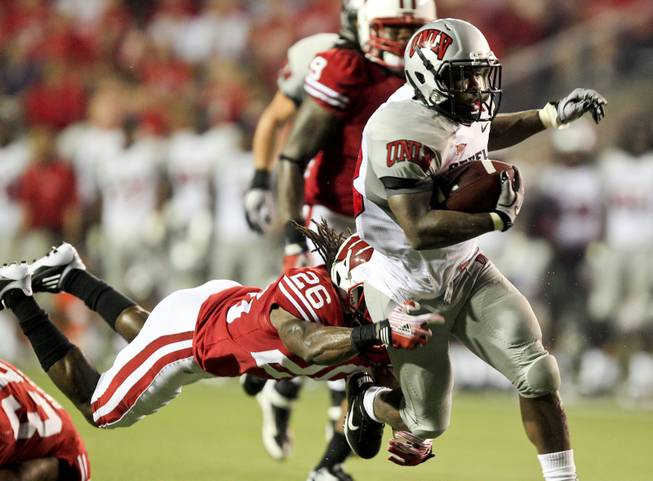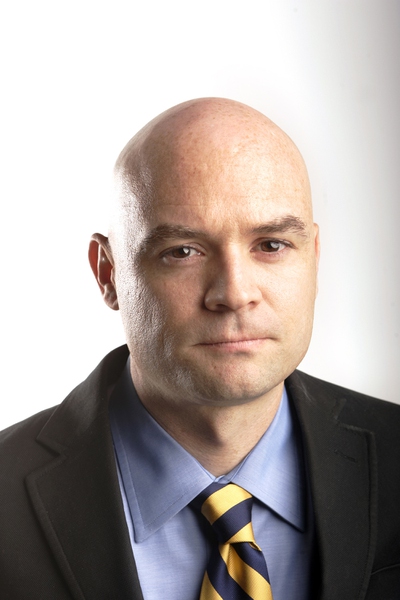
Associated Press
Wisconsin’s Antonio Fenelus (26) tackles UNLV running back Bradley Randle during the first half of their game Thursday night in Madison, Wis.
Friday, Sept. 2, 2011 | 2 a.m.
Sun archives
Even as I write this, the TV in our newsroom is tuned to ESPN a half-hour before our boys from UNLV get ready to take on the 11th-ranked University of Wisconsin Badgers.
The hype is in full effect, as only ESPN knows how to do it: “THE WAIT IS OVER” the type exclaims, and though the sound is down, I just know the music is a perfect amphetaminic complement.
For men of a certain age, ESPN has occupied a weird place in our lives. It’s grown up with us like a monstrously successful sibling.
I remember when I was 7 or 8: This is when I memorized sports stats obsessively and knew every bizarre bit of trivia — who tied Reggie Jackson for home run leader in 1982? Who was the 1983 Philadelphia 76ers shooting guard? (Answers at the bottom.) The world outside of playing sports, watching sports or anything related to “Star Wars” was pretty much drudgery. So, the idea of an all-sports network was like a calendar in which every day was Halloween or Christmas.
Of course back then ESPN was also something of a joke. The hours were often filled with replays of college baseball and some less-than mainstream sports. David Letterman did a top 10 list of the best ESPN sports, to include, “Amish Rake Fighting.”
But soon the nation’s insatiable need for sports and chicken wings came alive, right at the time that Keith Olbermann and Dan Patrick took “SportsCenter” to a new level, turning what had been a preposterously ponderous “news” program into the great gas that it deserved to be. And the rest is history: ESPN, for better or worse, is now the most dominant force in all of sports.
Back to tonight’s game: UNLV lost badly (as I write, it hasn’t happened yet, but I’ll take the liberty of predicting.) But at least it was on ESPN. (This reminds me of what was said of Nicaraguan dictator Anastasio Somoza: “He’s a sonofabitch, but he’s our sonofabitch.)
This has Las Vegas sports fans bringing up an old grudge: Why can’t our home games be on ESPN?
The simple answer is that as part of the Mountain West Conference, they’re contractually tied to an also-ran sports network — The Mtn.
But still they ask because just about everybody gets ESPN and because they know that star high school athletes we’re trying to recruit want to be on ESPN.
It’s a fair question, but the answer isn’t as simple as, let’s get on ESPN.
I talked to Javan Hedlund, associate commissioner of The Mountain West Conference, and here’s what he told me: Our conference is in the sixth year of a 10-year contract with The Mtn, which was created by CBS Sports and Comcast. Each school receives $1.5 million per year.
The network and its partners, CBS Sports Network and Versus, broadcast more than 50 football and 100 conference basketball games.
Mind you, The Mtn only reaches 8 to 10 million households and is available in 30 million households. CBS Sports Network and Versus, which each broadcast eight football games out of the total of more than 50, reach many more homes.
It ain’t ESPN.
But as Hedlund noted, when the deal was struck, ESPN didn’t make the conference a very good offer. The omnipotent sports empire offered a seven-year deal for $48 million compared with the 10 year, $120 million deal we got. Plus, if we went with ESPN, they would have broadcast just eight football games and 10 basketball games. Total. For the whole conference. And the football games would fall on Tuesday and Wednesday nights.
I don’t know about you, but where I come from, college football is played on Saturdays, and that’s so you can tailgate all day. Who tailgates on a Tuesday?
Still, it hurts not playing at home on ESPN. No doubt.
I asked UNLV Athletic Director Jim Livengood, who has been on the job 20 months, about the arrangement. He said, “We’re always looking for the best TV opportunities for our fans. The contract signed some time ago is the contract we’re living under right now. We’re always looking to re-evaluate, but contractual obligations are contractual obligations.”
A UNLV administrator, to whom I granted anonymity so the person could speak freely, said the purpose of college athletics contract is to provide exposure and raise money. The current arrangement, the source said, could be deemed weak on both counts.
On exposure: “ESPN is the mother ship. It resonates with kids, with everybody, and everybody has it,” the source said.
As for money, the source noted that Pac-12 schools, a group that with time — OK, a lot of time — we’d like to compete with academically and athletically, are each earning more than $17 million per year. “There’s a big difference there,” the source said.
With that financial disadvantage, how can we compete?
And that’s the point: We live in a winner-take-all society. We can’t compete unless we get on ESPN a lot, but we can’t get on ESPN a lot until we consistently beat the teams that are.
So, go get ’em, fellas.
(Trivia answers: Gorman Thomas, the lumbering truck driver of a designated hitter for the Milwaukee Brewers; and Andrew Toney, an all-star whose career fizzled somewhat mysteriously.)


Join the Discussion:
Check this out for a full explanation of our conversion to the LiveFyre commenting system and instructions on how to sign up for an account.
Full comments policy